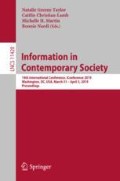Abstract
This paper qualitatively examines how teenagers in the US evaluate high stakes health information via social media. Through 30 semi-structured interviews with teens ages 13–18, we explore how teens interact with and make decisions about the quality of video-based exercise and nutrition content. Participants indicated that they are wary of advertisements and language that encourages extreme weight loss, yet prefer video content that is “fun” and engaging. Additionally, participants reported having explicit and implicit criteria for evaluating videos with health content that includes both graphic and content quality.
Access this chapter
Tax calculation will be finalised at checkout
Purchases are for personal use only
Notes
- 1.
While there are a myriad of names used to describe people and communities who debate the safety of vaccines (anti-vaccination, anti-vaxxers, vaccine safety advocates, etc.) [8], this example speaks to a current debate in which individuals and groups use social media platforms to exchange information and perspectives surrounding the effects of vaccines [9] (a high-stakes health topic).
References
Choi, W., Stvilia, B.: A new framework for web credibility assessment. In: iConference 2015 Proceedings (2015)
Gasser, U., Cortesi, S., Malik, M., Lee, A.: Youth and digital media: from credibility to information quality (2012)
Yang, J.Y., Rieh, S.Y.: A dyadic approach to information mediation at work: examining credibility and value perceptions (2013)
Starbird, K., Maddock, J., Orand, M., Achterman, P., Mason, R.M.: Rumors, false flags, and digital vigilantes: misinformation on Twitter after the 2013 Boston Marathon bombing. In: iConference 2014 Proceedings (2014)
Scolari, C.A., Masanet, M.J., Guerrero-Pico, M., Establés, M.J.: Transmedia literacy in the new media ecology: teens’ transmedia skills and informal learning strategies. El profesional de la información (EPI) 27(4), 801–812 (2018)
Mudliar, P., Raval, N.: “They are like personalized mini-Googles”: seeking information on Facebook groups. In: Proceedings of the 51st Hawaii International Conference on System Sciences (2018)
Barkhuus, L., Bales, E., Cowan, L.: Internet ecologies of new mothers: trust, variety and strategies for managing diverse information sources. In: Proceedings of the 50th Hawaii International Conference on System Sciences (2017)
Koltai, K., Fleischmann, K.R.: Questioning science with science: the evolution of the vaccine safety movement. Paper presented at the 80th annual meeting of the association for information science and technology, Washington, DC (2017)
Wilson, K., Keelan, J.: Social media and the empowering of opponents of medical technologies: the case of anti-vaccinationism. J. Med. Internet Res. 15(5), e103 (2013). https://doi.org/10.2196/jmir.2409
Metzger, M.J.: Making sense of credibility on the Web: models for evaluating online information and recommendations for future research. J. Am. Soc. Inf. Sci. 58, 2078–2091 (2007)
Fogg, B.J., Tseng, H.: The elements of computer credibility. In: Proceedings of the SIGCHI Conference on Human Factors in Computing Systems (CHI 1999), pp. 80–87. ACM, New York (1999)
Gefen, D.: Reflections on the dimensions of trust and trustworthiness among online consumers. ACM SIGMIS Database 33(3), 38–53 (2002)
Gasser, U., Cortesi, S., Malik, M., Lee, A.: Youth and digital media: from credibility to information quality. Berkman Center Research Publication No. 2012–1 (2012). http://ssrn.com/abstract=2005272
Wartella, E., Rideout, V., Zupancic, H., Beaudoin-Ryan, L., Lauricella, A.: Teens, technology, and health: a national survey. Center on Media and Human Development, School of Communication, Northwestern University (2015)
Wartella, E., Rideout, V., Montague, H., Beaudoin-Ryan, L., Lauricella, A.: Teens, health and technology: a national survey. Media Commun. 4(3), 12 (2016)
Eikey, E.V., Booth, K.: Recovery and maintenance: how women with eating disorders use Instagram. In: iConference 2017, Wuhan, China, 22–25 March 2017
Tiggemann, M., Zaccardo, M.: Exercise to be fit, not skinny: the effect of fitspiration imagery on women’s body image. Body Image 15, 61–67 (2015). http://linkinghub.elsevier.com/retrieve/pii/S17401445150008
Tiggemann, M., Zaccardo, M.: Strong is the new skinny: a content analysis of #fitspiration images on Instagram. J. Health Psychol. 23, 1003 (2016)
Syed-Abdul, S., et al.: Misleading health-related information promoted through video-based social media: anorexia on YouTube. J. Med. Internet Res. 15(2), e30 (2013)
Carrotte, E.R., Vella, A.M., Lim, M.S.: Predictors of “liking” three types of health and fitness-related content on social media: a cross-sectional study. J. Med. Internet Res. 17(8), e205 (2015)
Evans, W., Wolfe, B., Adler, N.: The SES and health gradient: a brief review of the literature. In: Biological Consequences of Socioeconomic Inequalities, p. 292 (2012)
Boichak, O., Jackson, S., Hemsley, J., Tanupabrungsun, S.: Automated diffusion? Bots and their influence during the 2016 U.S. Presidential Election. In: Chowdhury, G., McLeod, J., Gillet, V., Willett, P. (eds.) iConference 2018. LNCS, vol. 10766, pp. 17–26. Springer, Cham (2018). https://doi.org/10.1007/978-3-319-78105-1_3
Author information
Authors and Affiliations
Corresponding author
Editor information
Editors and Affiliations
Rights and permissions
Copyright information
© 2019 Springer Nature Switzerland AG
About this paper
Cite this paper
Booth, K.M., Trauth, E.M. (2019). Moving Beyond Text: How Teens Evaluate Video-Based High Stakes Health Information via Social Media. In: Taylor, N., Christian-Lamb, C., Martin, M., Nardi, B. (eds) Information in Contemporary Society. iConference 2019. Lecture Notes in Computer Science(), vol 11420. Springer, Cham. https://doi.org/10.1007/978-3-030-15742-5_49
Download citation
DOI: https://doi.org/10.1007/978-3-030-15742-5_49
Published:
Publisher Name: Springer, Cham
Print ISBN: 978-3-030-15741-8
Online ISBN: 978-3-030-15742-5
eBook Packages: Computer ScienceComputer Science (R0)

